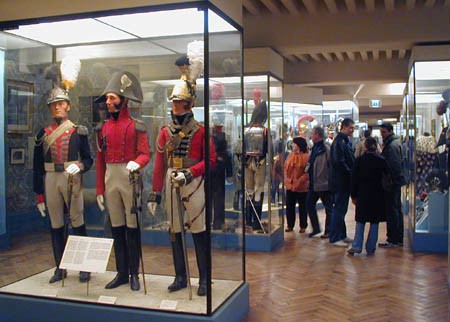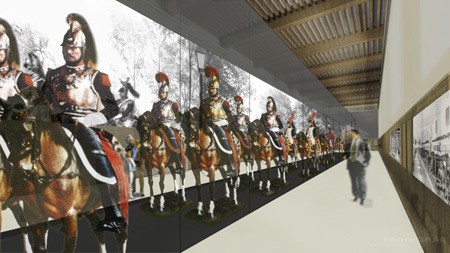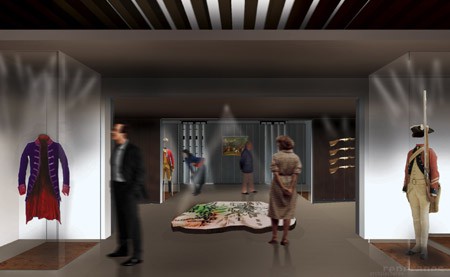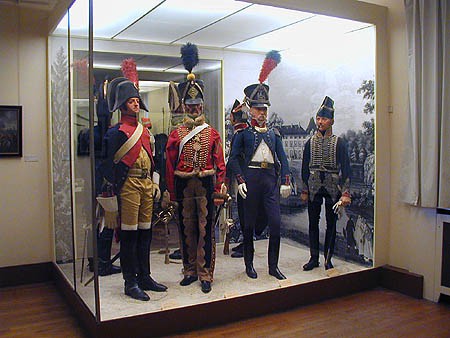The origins of the Musée de l’Armée
Before turning to the huge army museum renovation project ATHENA, I would like just to talk about the creation of the museum in 1905 and the exhibition (which closes on 15 January, 2006), marking the museum's centenary.
This year we're celebrating the centenary of the founding decree of 26 July, 1905, which brought two pre-existing institutions together to create the Musée de l'Armée as we know it today. These two institutions were the Musée d'Artillerie artillery museum and the Musée historique de l'Armée (Army Historical Museum), both physically present on the site of the Hôtel des Invalides.
The artillery museum was created during the Revolution and contained basically the collection of the garde-meuble de la Couronne (Crown wardrobe) and that of the Princes de Condé (Chantilly). This museum was installed at Les Invalides in 1872. As for the Army Historical Museum, it was founded in 1896 by the Sabretache and its then president, the painter Edouard Detaille. With these two ensembles, you mustn't forget the Nécropole militaire (military necropolis), which contains notably the tombs of Turenne, Vauban, Foch, Lyautey, and Joseph and Jérôme Bonaparte. In fact, the necropolis was in a certain sense created by Napoleon since it was he who had the mortal remains of Turenne and the the heart of Vauban exhumed and re-buried under the dome of the royal chapel here.
How were the two collections brought together and developed?
On the one hand, the artillery museum was very intellectual, presenting the evolution of arms, the advances in technical capabilities and also showing uniforms, and on the other, the Army historical museum was an evocation of the « panache » of the French army. Little by little, and not without some difficulty, the two contrasting collections were fused. Today the Musée de l'Armée, until recently a museum of objects, has become a museum of history, in which defeats just as much as victories also find their place.
 What are the broad outlines of the ATHENA project?
What are the broad outlines of the ATHENA project?
It's constructed around three specific entities, each built on an emblematic figure closely related to the place, namely Louis XIV, Napoléon I, and Charles de Gaulle. «Louis XIV is our landlord, and Napoleon our daily bread», was how one of my predecessors, Jacques Perrot, jokingly but accurately used to put it.
The main idea behind the project is to make the spatial organisation and the attributions of the different wings completely coherent: the West, East and South-West wings are each characterised by a specific theme or time period.
The museum is however fundamentally arranged on chronological basis. So our idea is fundamentally to reinforce its status as a museum of history, where we present the development of the army, arms, and military systems, but with a constant reference to political power, to the nexus Army/Nation as an expression of national power, be it royal (Louis XIV), imperial (Napoleon I) or republican (Charles de Gaulle).
This is clearly a big project. How have you organised it?
The project is divided up into 5 phases. The first, ATHENA I, (1996 to 2000), concentrated on creating galleries centred on the Second World War, General de Gaulle, and Free French Forces (Forces françaises libres). ATHENA II (2003-2005) dealt with the West Wing (Aile d'Occident) and the rooms containing the « départment ancien » or « old collection » of arms and armour – these galleries opened just recently on 17 December, 2005 – and the 1871-1939 galleries on the upper floors of the same wing. This second phase included some refurbishment of some of the Second World War galleries, with the aim of creating a large department dedicated to the two world wars by 1 July 2006. ATHENA III concerns the East Wing (aile d'Orient) and the modern department galleries, ranging from the minority of Louis XIV to the fall of Napoleon III. Work on this phase is to begin in January 2006, finishing at the end of 2007. ATHENA IV (South East) corresponds to the creation of the “Historial Charles de Gaulle”. The final phase, ATHENA V, ties up all the loose ends in the different projects, including, for example, the creation of a gallery for temporary exhibitions.
The ATHENA project today
 After the call for tender, five architects' firms were selected, one for each phase of the project. Repérages Architecture were chosen for the East wing. What were the reasons for this choice?
After the call for tender, five architects' firms were selected, one for each phase of the project. Repérages Architecture were chosen for the East wing. What were the reasons for this choice?
One of the points we put the most weight on was the architectural project proposed, that is, the way in which they foresaw that the development would ‘marry' the existing structures but without being too ‘present', thus hampering further elaboration. Team selection and management within the company chosen was also for us a deciding factor, particularly as far as staying on schedule was concerned; although that was of course not the only criterion. We wanted to establish permanently open channels of communication between the architects and the curators, between those with the knowledge of the objects and those with the ideas for how to exhibit them. Repérages Architecture seemed to us to be excellent, both in their sensitivity to the existing building and the quality of their museographical project.
Did the fact that a majority of the Musée de l'Armée's visitors comes from abroad influence your thinking in any particular way?
Yes, of course. The Musée de l'Armée receives about 1.1 million visitors annually, of which about 800 000 come from abroad. We reacted to this statistic in three ways: the first related to signposting and visitor flux; here we use pictograms systematically. Each department is characterised by a specific image: a stylised piece of armour for the “old department”, a horseman (probably a Chasseur à cheval de la Garde) for the “modern department”, and a tank for the section dedicated to the two world wars.
Furthermore, references to well-known figures will help people to orientate themselves within the museum.
And finally, our audio guide aims to provide a definitive solution for this most cosmopolitan of publics. It is currently available in 8 languages, and this will soon rise to 12. For reasons of space, however, the object descriptions are only available in French, English, Spanish and German.
Do you have any elements which are specifically aimed at children in the ATHENA project?
It is true that curators sometimes (for reasons of precision) are led to use recondite terminology. But the information panels are always re-read by our education service so as to ensure that they are comprehensible for a younger public. We also intend to continue our schools outreach programme, in which we offer lots of workshops and very popular guided tours.
The East Wing (Aile Orient) and the Napoleonic rooms
 The First and Second Empire rooms are going to be closed to the public from 9 January 2006 for 2 years. When the work's over, what will the public see?
The First and Second Empire rooms are going to be closed to the public from 9 January 2006 for 2 years. When the work's over, what will the public see?
Well, every department will have its own style. We going to keep the renowned Sabretache feel, what I mean is a very « colourful » atmosphere, particularly at the level of the many and varied uniforms on display. But that's not true of the “old department”, where the armour and arms require a completely different visual and aesthetic approach. If you were asked characterise the three areas, you could say that the “old department” was that of the men dressed in iron, the modern department was that of the men dressed in brightly coloured uniforms, and the department of the two world wars was that of the men packed into tin cans.
In the cafeteria on the north-east side, we've a special display case: 40 metres long with mounted mannequins made by Detaille and other artists, perhaps including a First-Empire horse-drawn gun train. We're going to make it look like the figures are moving, like it's a procession. It will look be very impressive.
There's also going to be gallery with about 2,500 to 3,000 historical figurines on display. By rotating the figurines we should be able to show a good deal of the 150,000 in storage.
How are you going to organise the chronological and thematic elements within a single gallery?
As a general rule, in all the galleries, the visit is first and foremost chronological, with thematic information (political organisation or army organisation, for example) arranged around this. In the 18th-century gallery, there will be a section dedicated to the King's Household. In the Napoleonic First-Empire galleries, we will be including the theme «war built the empire», «war destroyed the empire», not to mention a treatment of the Imperial Grand Headquarters (Grand Quartier Général imperial); not forgetting of course the theme which runs through the whole museum, namely, the relationship between power and the army.
There's also a mixed gallery which combines flags, symbols and music. How is that going to work?
Flags are a facet of national representation and as such are a sensitive matter, rendered almost religious by the Third Republic. Unfortunately we can't have today the huge gallery containing 300 standards which we once had – the flags are too fragile. So we are having copies made. And this will make it possible to relive the special emotion of seeing the church decked out in this way.
 And it would be unthinkable today to have a “modern” museum which did not have some multimedia elements. How have you introduced elements of sound and digital images into your scenography?
And it would be unthinkable today to have a “modern” museum which did not have some multimedia elements. How have you introduced elements of sound and digital images into your scenography?
Yes, multimedia is obligatory today! In every age, war had its own particular sound, which in itself was linked to the technology of the arms of the period: hence, from time to time (so as to avoid its becoming annoying) throughout the museum, you can hear not only the noise of battle but also an army marching, although it's clear that a Roman legion doesn't make the same sound as the cavalry reserve of the Grande Armée. Specific areas have also been dedicated to audiovisual elements, and here the public can watch films in comfort.
To cap it all, there will be evocations of some great battles, notably Austerlitz, (but also Waterloo, since we after all a museum of history!). We are going to have a special system projecting the development of the battle onto a relief map at ground level. We hope that this will be very lively and educational. Obviously, this type of production works particularly well with the pitched battles of the modern period. It is less effective for medieval battles, for example.
As for those who are unhappy to see almost one third of the collection currently on show disappear, what is your reply?
People forget that the rules governing public spaces are wide ranging, and that as a matter of course this has an effect on the way you organise your space: there are rules for regulating people traffic, handicapped access, security, etc. It is true that about a third of the objects will not be exhibited. But that doesn't mean that these will never be seen again. Indeed, the situation is a salutary one for the objects themselves since we can programme when they go on show. Because, despite the precautions you can take, the pieces are fragile (particularly the textiles), and they get more so when exhibited.
On the other hand, when you've got too many pieces in a show case, it's no longer very clear what's going on, and it's hard to learn a great deal. That being said, many of the objects to be removed will not be going into storage but will rather be put on long-term deposits in other museums.
There's talk of a temporary exhibition set up around the emperor's tomb, can you tell me more about this?
While the galleries are closed, we are aiming to open an exhibition (starting on 1 March) of about twenty or so pieces around the theme of the “person” of Napoleon, namely, his hat, his great coat, the sword of Austerlitz, the great necklace of the Légion d'honneur. This project is designed by Michel Albertini, and he has come up with a solution – the creation of a supplementary chapel in the space – which looks great.
Another key element in museum management is the entrance fee. Are there to be any changes at that level? Have you thought about creating an entrance fee system related to the galleries people visit. For example, you might offer a ticket which gives you access to Napoleon's tomb and to the First Empire galleries?
Yes, we're going to have tickets which correspond to visits to certain galleries and which have those galleries' departments' logos marked on them, but always with Napoleon's Tomb as the “added extra”, for want a better expression. In this way, one visitor could just visit the “old department” and Napoleon's Tomb, whilst another could do the modern tour and also visit the tomb, etc. There will probably also be a two-day visit ticket so as to enable the public to see the entire museum at their own pace.
To conclude, what would you like the public to feel after having visited the Musée de l'Armée?
Three things. Firstly, emotion; you can't but be affected by certain objects: the armour for a child, for example. Secondly, I would also like visitors to understand that armed force emanates from, and is indeed sometimes the embodiment of, a nation. This force does not exist in a vacuum, it is not an autonomous system which alone creates wars. That is why in our minds we have always associated the army with the nation and with the person who exercises power in the name of that nation. And thirdly, I would like visitors to come away with a sense of the continuity visible in the single fact that army has always served the nation through all the different forms of expression of the power which the nation might have had.


